Franklin D. Roosevelt Pearl Harbor Speech - Dec. 8, 1941
|
|
|
Date:September 1, 1939 – September 2, 1945 Location: Europe, Pacific, Atlantic, South-East Asia, China, Middle East, Mediterranean and Africa Result: Allied victory. Creation of the United Nations. Emergence of the United States and the Soviet Union as superpowers. Creation of NATO and Warsaw Pact. Spheres of influence in Europe leading to the Cold War. |
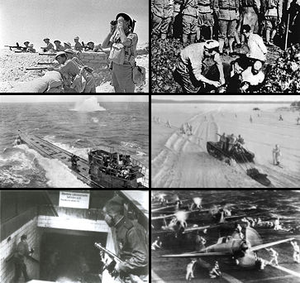 (Image:
Clockwise from top left: Commonwealth troops in the desert; Chinese civilians being buried alive by Japanese soldiers; Soviet forces during a
winter offensive; Carrier-borne Japanese planes readying for take off; Soviet troops fighting in Berlin; A German submarine under attack.)
(Image:
Clockwise from top left: Commonwealth troops in the desert; Chinese civilians being buried alive by Japanese soldiers; Soviet forces during a
winter offensive; Carrier-borne Japanese planes readying for take off; Soviet troops fighting in Berlin; A German submarine under attack.)
World War II, or the Second World War, (often abbreviated WWII or WW2) was a global military conflict which involved a majority of the world's nations, including all of the great powers, organised into two opposing military alliances: the Allies and the Axis. The war involved the mobilisation of over 100 million military personnel, making it the most widespread war in history. In a state of "total war", the major participants placed their complete economic, industrial, and scientific capabilities at the service of the war effort, erasing the distinction between civilian and military resources. Over seventy million people, the majority of them civilians, were killed, making it the deadliest conflict in human history.
The start of the war is generally held to be in September 1939 with the German invasion of Poland and subsequent declarations of war on Nazi Germany by the British Commonwealth and France. Many belligerents entered the war before or after this date, during a period which spanned from 1937 to 1941, as a result of other events. Amongst these main events are the Marco Polo Bridge Incident (fought between Nationalist China and Japan), the start of Operation Barbarossa (the Nazi invasion of Russia), and the attacks on Pearl Harbor and British and Dutch colonies in South East Asia.
Background
In the aftermath of World War I, a defeated Germany signed the Treaty of Versailles. This caused Germany to lose a significant portion of its territory, prohibited the annexation of other states, limited the size of German armed forces and imposed massive reparations. Russia's civil war led to the creation of the Soviet Union which soon was under the control of Joseph Stalin. In Italy, Benito Mussolini seized power as a fascist dictator promising to create a "New Roman Empire." The Kuomintang (KMT) party in China launched a unification campaign against regional warlords and nominally unified China in the mid-1920s, but was soon embroiled in a civil war against its former Chinese communist allies. In 1931, an increasingly militaristic Japanese Empire, which had long sought influence in China as the first step of its right to rule Asia, used the Mukden Incident as justification to invade Manchuria; the two nations then fought several small conflicts, in Shanghai, Rehe and Hebei until the Tanggu Truce in 1933. Afterwards Chinese volunteer forces continued the resistance to Japanese aggression in Manchuria, and Chahar and Suiyuan.
The Soviet Union and the United States emerged from the war as the world's superpowers. This set the stage for the Cold War, which lasted for the next 45 years. The United Nations was formed in the hope of preventing another such conflict. The self-determination spawned by the war accelerated decolonisation movements in Asia and Africa, while Western Europe itself began moving toward integration.
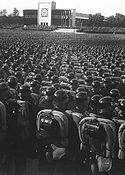 (Image: German
troops at the 1935 Nuremberg Rally.)
(Image: German
troops at the 1935 Nuremberg Rally.)
Adolf Hitler, after an unsuccessful attempt to overthrow the German government in 1923, became the leader of Germany in 1933. He abolished democracy, espousing a radical racially motivated revision of the world order, and soon began a massive rearming campaign. This worried France and the United Kingdom, who had lost much in the previous war, as well as Italy, which saw its territorial ambitions threatened by those of Germany. To secure its alliance, the French allowed Italy a free hand in Ethiopia, which Italy desired to conquer. The situation was aggravated in early 1935 when the Saarland was legally reunited with Germany and Hitler repudiated the Treaty of Versailles, speeding up remilitarisation and introducing conscription. Hoping to contain Germany, the United Kingdom, France and Italy formed the Stresa Front. The Soviet Union, concerned due to Germany's goals of capturing vast areas of eastern Europe, concluded a treaty of mutual assistance with France.
Before taking effect though, the Franco-Soviet pact was required to go through the bureaucracy of the League of Nations, rendering it essentially toothless and in June 1935, the United Kingdom made an independent naval agreement with Germany easing prior restrictions. The United States, concerned with events in Europe and Asia, passed the Neutrality Act in August. In October, Italy invaded Ethiopia, with Germany the only major European nation supporting her invasion. Italy then revoked objections to Germany's goal of making Austria a satellite state.
In direct violation of the Versailles and Locarno treaties, Hitler remilitarized the Rhineland in March 1936. He received little response from other European powers. When the Spanish Civil War broke out in July, Hitler and Mussolini supported fascist Generalísimo Francisco Franco's nationalist forces in his civil war against the Soviet-supported Spanish Republic. Both sides used the conflict to test new weapons and methods of warfare and the nationalists would prove victorious in early 1939.
With tensions mounting, efforts to strengthen or consolidate power were made. In October, Germany and Italy formed the Rome-Berlin Axis and a month later Germany and Japan, each believing communism and the Soviet Union in particular to be a threat, signed the Anti-Comintern Pact, which Italy would join in the following year. In China, the Kuomintang and communist forces agreed on a ceasefire to present a united front to oppose Japan.
Chronology
The start of the war is generally held to be in September 1, 1939 with the German invasion of Poland. Other dates for the beginning of war include the Japanese invasion of Manchuria in 1931, the start of the Second Sino-Japanese War in 1937, or one of several other events. Other sources follow A. J. P. Taylor, who holds that there was a simultaneous Sino-Japanese War in East Asia, and a Second European War in Europe and her colonies, but they did not become a World War until they merged in 1941; at which point the war continued until 1945. This article uses the conventional dating.
The end of the War also has several dates. Some sources end it from the armistice of August 14, 1945, rather than the formal surrender of Japan (September 2, 1945); in some European histories, it ended on V-E Day (May 8, 1945). The Treaty of Peace with Japan was not signed until 1951.
Course of the war
War in China
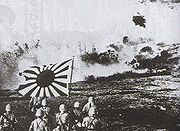 (Image:
Japanese forces during the Battle of Wuhan.)
(Image:
Japanese forces during the Battle of Wuhan.)
In mid-1937, following the Marco Polo Bridge Incident, Japan began a full invasion of China. The Soviets quickly lent support to China, effectively ending China's prior cooperation with Germany. Starting at Shanghai, the Japanese pushed Chinese forces back, capturing the capital Nanjing in December. In June 1938 Chinese forces stalled the Japanese advance by flooding the Yellow River; though this bought time to prepare their defenses at Wuhan, the city was still taken by October. During this time, Japanese and Soviet forces engaged in a minor skirmish at Lake Khasan; in May 1939, they became involved in a more serious border war that ended with signing a cease-fire agreement on September 15 and restoring the status quo.
War breaks out in Europe
(Image: German Heinkel He 111 planes bombing Warsaw in 1939)
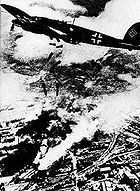 In
Europe, Germany and Italy were becoming bolder. In March 1938 Germany annexed Austria, again provoking little response from other European
powers. Encouraged, Hitler began pressing German claims on the Sudetenland, an area of Czechoslovakia with a predominantly ethnic German population;
France and Britain conceded this territory to him, against the wishes of the Czechoslovak government, in exchange for a promise of no further
territorial demands. However, soon after that, Germany and Italy forced Czechoslovakia to cede additional territory to Hungary and Poland.
In March 1939 Germany invaded the rump of Czechoslovakia and subsequently split it into the German Protectorate of Bohemia and Moravia and the
pro-German Slovak Republic.
In
Europe, Germany and Italy were becoming bolder. In March 1938 Germany annexed Austria, again provoking little response from other European
powers. Encouraged, Hitler began pressing German claims on the Sudetenland, an area of Czechoslovakia with a predominantly ethnic German population;
France and Britain conceded this territory to him, against the wishes of the Czechoslovak government, in exchange for a promise of no further
territorial demands. However, soon after that, Germany and Italy forced Czechoslovakia to cede additional territory to Hungary and Poland.
In March 1939 Germany invaded the rump of Czechoslovakia and subsequently split it into the German Protectorate of Bohemia and Moravia and the
pro-German Slovak Republic.
Alarmed, and with Hitler making further demands on Danzig, France and Britain guaranteed their support for Polish independence; when Italy conquered Albania in April 1939, the same guarantee was extended to Romania and Greece. Shortly after the Franco-British pledges to Poland, Germany and Italy formalized their own alliance with the Pact of Steel.
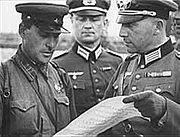 (Image:
Soviet and German officers in Poland, September 1939.)
(Image:
Soviet and German officers in Poland, September 1939.)
In August 1939 Germany and the Soviet Union signed a non-aggression pact. This treaty included a secret protocol to split Poland and Eastern Europe into separate spheres of influence.
On September 1, 1939, Adolf Hitler launched his invasion of Poland and World War II broke out. France, Britain, and the countries of the Commonwealth declared war on Germany but provided little military support to Poland other than a small French attack into the Saarland. On September 17, 1939, after signing an armistice with Japan, the Soviets launched their own invasion of Poland. By early October, the campaign ended with division of Poland among Germany, the Soviet Union, Lithuania and Slovakia, although officially Poland never surrendered.
At the same time as the battle in Poland, Japan launched its first attack against Changsha, a strategically important Chinese city, but was repulsed by early October.
Following the invasion of Poland, the Soviet Union began moving troops into the Baltic States. Finnish resistance to similar pressure by the Soviet Union in late November led to the four-month Winter War, ending with Finnish concessions. France and the United Kingdom, treating the Soviet attack on Finland as tantamount to entering the war on the side of the Germans, responded to the Soviet invasion by supporting its expulsion from the League of Nations. Though China had the authority to veto such an action, it was unwilling to alienate itself from either the Western powers or the Soviet Union and instead abstained. The Soviet Union was displeased by this course of action and as a result suspended all military aid to China. By June 1940, the Soviet Armed Forces completed the occupation of the Baltic States.
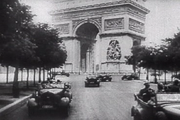 (Image:
German troops in Paris after the fall of France.)
(Image:
German troops in Paris after the fall of France.)
In Western Europe, British troops deployed to the Continent, but neither Germany nor the Allies launched direct attacks on the other. The Soviet Union and Germany entered a trade pact in February of 1940, pursuant to which the Soviets received German military and industrial equipment in exchange for supplying raw materials to Germany to help circumvent a British blockade. In April, Germany invaded Denmark and Norway to secure shipments of iron-ore from Sweden which the allies would try to disrupt. Denmark immediately capitulated, and despite Allied support, Norway was conquered within two months. British discontent over the Norwegian campaign led to the replacement of Prime Minister Neville Chamberlain by Winston Churchill on May 10, 1940.
Axis advances
On that same day, Germany invaded France and the Low Countries. The Netherlands and Belgium were overrun using blitzkrieg tactics in a few weeks. The French fortified Maginot Line was circumvented by a flanking movement through the Ardennes region, mistakenly perceived by France as an impenetrable natural barrier against armored vehicles. British troops were forced to evacuate the continent at Dunkirk, abandoning their heavy equipment by the end of the month. On June 10, Italy invaded, declaring war on both France and the United Kingdom; twelve days later France surrendered and was soon divided into German and Italian occupation zones, and an unoccupied rump state under the Vichy Regime. On July 14, the British attacked the French fleet in Algeria to prevent their seizure by Germany.
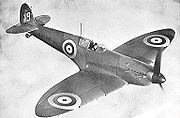 (Image:
The RAF Supermarine Spitfire, used extensively during the Battle of Britain.)
(Image:
The RAF Supermarine Spitfire, used extensively during the Battle of Britain.)
With France neutralized, Germany began an air superiority campaign over Britain to prepare for an invasion. The campaign failed and by September the invasion plans were cancelled. Using newly captured French ports the German Navy enjoyed success against an over-extended Royal Navy, using U-boats against British shipping in the Atlantic. Italy began operations in the Mediterranean, initiating a siege of Malta in June, conquering British Somaliland in August, and making an incursion into British-held Egypt in early September. Japan increased its blockade of China in September by seizing several bases in the northern part of the now-isolated French Indochina.
Throughout this period, the neutral United States took measures to assist China and the Western Allies. In November 1939, the American Neutrality Act was amended to allow Cash and carry purchases by the Allies. In 1940, following the German capture of Paris, the size of United States Navy was significantly increased and after the Japanese incursion into Indochina, the United States embargoed iron, steel and mechanical parts against Japan. In September, the United States further agreed to a trade of American destroyers for British bases. Still, a large majority of the American public continued to oppose any direct military intervention into the conflict well into 1941.
At the end of September the Tripartite Pact between Japan, Italy and Germany formalized the Axis Powers. The pact stipulated, with the exception of the Soviet Union, any country not in the war which attacked any Axis Power would be forced to go to war against all three. The Soviet Union expressed interest in joining the Tripartite Pact, sending a modified draft to Germany in November and offering a very German-favourable economic deal; while Germany remained silent on the former, they accepted the latter. Regardless of the pact, the United States continued to support the United Kingdom and China by introducing the Lend-Lease policy and creating a security zone spanning roughly half of the Atlantic Ocean where the United States Navy protected British convoys. As a result, Germany and the United States found themselves engaged in sustained, if undeclared, naval warfare in the North Atlantic by October 1941, even though the United States remained officially neutral.
The Axis expanded in November 1940 when Hungary, Slovakia and Romania joined the Tripartite Pact. These countries participated in the subsequent invasion of the USSR, with Romania making the largest contribution in order to recapture territory ceded to the USSR and pursue its leader's desire to combat communism.
In October, Italy invaded Greece but within days were repulsed and pushed back into Albania, where a stalemate soon occurred. Shortly after this, in Africa, Commonwealth forces launched offensives against Egypt and Italian East Africa. By early 1941, with Italian forces having been pushed back into Libya by the Commonwealth, Churchill ordered a dispatch of troops from Africa to bolster the Greeks. The Italian Navy also suffered significant defeats, with the Royal Navy putting three Italian battleships out of commission via carrier attack at Taranto, and several more warships neutralized at Cape Matapan.
 (Image: German
paratroopers invading Crete.)
(Image: German
paratroopers invading Crete.)
The Germans soon intervened to assist Italy. Hitler sent German forces to Libya in February and by the end of March they had launched an offensive against the diminished Commonwealth forces. In under a month, Commonwealth forces were pushed back into Egypt with the exception of the besieged port of Tobruk. The Commonwealth attempted to dislodge Axis forces in May and again in June, but failed on both occasions. In early April the Germans similarly intervened in the Balkans, invading Greece and Yugoslavia; here too they made rapid progress, eventually forcing the Allies to evacuate after Germany conquered the Greek island of Crete by the end of May.
The Allies did have some successes during this time though. In the Middle East, Commonwealth forces first quashed a coup in Iraq which had been supported by German aircraft from bases within Vichy-controlled Syria, then, with the assistance of the Free French, invaded Syria and Lebanon to prevent further such occurrences. In the Atlantic, the British scored a much needed public morale boost by sinking the German flagship Bismarck. Perhaps most importantly, during the Battle of Britain the Royal Air Force had successfully resisted the Luftwaffe's assault, and on May 11, 1941, Hitler called off the bombing campaign.
In Asia, in spite of several offensives by both sides, the war between China and Japan was stalemated by 1940. In August of that year, Chinese communists launched an offensive in Central China; in retaliation, Japan instituted harsh measures in occupied areas to reduce human and material resources for the communists. Mounting tensions between Chinese communist and nationalist forces culminated in January 1941, effectively ending their co-operation.
With the situation in Europe and Asia relatively stable, Germany, Japan and the Soviet Union made preparations. With the Soviets wary of mounting tensions with Germany and the Japanese planning to take advantage of the European War by seizing resource-rich European possessions in Southeast Asia the two powers signed a neutrality agreement in April, 1941. By contrast the Germans were steadily making preparations for an attack on the Soviet Union, amassing forces on the Soviet border.
The war becomes global
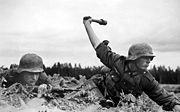 (Image:
German soldiers in the Invasion of the Soviet Union, 1941.)
(Image:
German soldiers in the Invasion of the Soviet Union, 1941.)
On June 22, 1941, Germany, along with other European Axis members and Finland, invaded the Soviet Union. The primary objectives of this surprise offensive were the Baltic region, Moscow and Ukraine with an ultimate goal to end campaign of 1941 near the line connecting Caspian and White Seas. Hitler's goals were to eliminate the Soviet Union as a military power, exterminate Communism, generate so-called 'living space' by dispossessing the native population and provide guaranteed access to the strategic resources needed to defeat Germany's remaining rivals. Although before the war the Red Army was preparing for a strategic counter-offensive, "Barbarossa"' forced Stavka to adopt a strategic defence. During the summer, Axis made significant gains into Soviet territory, inflicting immense losses in personnel and matériel, however by the middle of August, German OKH decided to suspend the offensive of a considerably depleted Army Group Center, and to divert a part of its armored force to reinforce troops advancing toward central Ukraine and Leningrad. The Kiev offensive was overwhelmingly successful, resulting in encirclement and elimination of four Soviet armies, and made further advance into Crimea and industrially developed Eastern Ukraine possible.
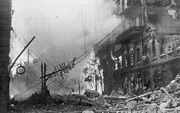 (Image:
Khreshchatyk, the main street of Kiev, after German bombardment)
(Image:
Khreshchatyk, the main street of Kiev, after German bombardment)
The diversion of three quarters of Axis troops and majority of air forces from France and central Mediterranean to the East prompted the United Kingdom to reconsider her grand stategy. In July, the United Kingdom and the Soviet Union formed a military alliance against Germany and shortly after jointly invaded Iran to secure the Persian Corridor and Iran's oilfields. In August, the United Kingdom and the United States jointly issued the Atlantic Charter. In November, Commonwealth forces launched a counter-offensive in the desert, reclaiming all gains the Germans and Italians had made.
Japan, hoping to capitalize on Germany's success in Europe, made several demands, including a steady supply of oil, from the Dutch East Indies; these talks, however, broke down in June. In July, Japan seized military control of southern Indochina since it would not only put her in a better position to coerce the Dutch East Indies into yielding, but it would also be a blow against China; should war be necessary, it also improved their strategic position against the Americans and British. The United States, United Kingdom and other western governments reacted to the seizure of Indochina with a freeze on assets, while the United States (which supplied 80% of Japan's oil) responded by placing a complete oil embargo. Thus Japan was essentially forced to choose between withdrawing from Asia, or seizing the oil she needed by force; the Japanese military did not consider the former an option, and many officers considered the oil embargo an unspoken declaration of war. The Imperial General Headquarters thus planned to create a large perimeter stretching into the Central Pacific in order to facilitate a defensive war while exploiting the resources of Southeast Asia; to prevent intervention while securing the perimeter it was further planned to neutralize the United States Pacific Fleet on the outset.
By October, when Axis operational objectives in Ukraine and the Baltic region were achieved, with only Leningrad and Sevastopol resisting in sieges a major offensive against Moscow had been renewed. After two months of fierce battles, the German army almost reached Moscow suburbs, where the exhausted troops were forced to suspend their offensive. Despite impressive territorial gains, no strategic goals of the campaign had been fully accomplished: two major Soviet cities hadn't been captured, Red Army's capability to resist was not broken, and the Soviet Union retained a considerable part of its military potential. The blitzkrieg phase of WWII in Europe had ended.
By early December, freshly mobilized reserves allowed the Soviets to achieve numerical parity with Axis troops. This, as well as intelligence data that established a minimal amount of Soviet troops in the East sufficient to prevent Japanese Kwantung Army from the attack, allowed the Soviets to mount a massive counter-offensive that started on December 5 along 1000 km front and pushed German troops 100-250 km west.
Video - World War II Film - Japanese Bombing of Pearl Harbor
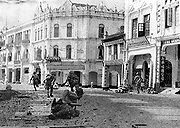 (Image:
Japanese troops advancing through Kuala Lumpur.)
(Image:
Japanese troops advancing through Kuala Lumpur.)
Two days later, on December 7, Japan attacked British, Dutch and American holdings with near simultaneous offensives against Southeast Asia and the Central Pacific. These included an attack on the American naval base of Pearl Harbor and landings in Thailand and Malaya.
These attacks prompted the United States, United Kingdom, other Western Allies and China (already a belligerent), to formally declare war on Japan. Germany and the other members of the Tripartite Pact responded by declaring war on the United States. In January, the United States, United Kingdom, Soviet Union, China and twenty-two smaller or exiled governments issued the Declaration by United Nations which affirmed the Atlantic Charter. The Soviet Union did not adhere to the declaration, and maintained a neutrality agreement with Japan and exempted herself from the principle of self-determination.
British Crusader tanks moving to forward positions during the North Africa Campaign.
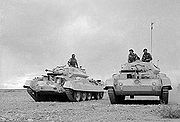 (Image:
British Crusader tanks moving to forward positions during the North Africa Campaign.)
(Image:
British Crusader tanks moving to forward positions during the North Africa Campaign.)
Meanwhile, by the end of April, 1942, Japan had almost fully conquered Burma, Philippines, Malaya, Dutch East Indies, Singapore, inflicting severe losses on Allied troops and taking a large number of prisoners. They also achieved naval victories in the South China Sea, Java Sea and Indian Ocean and bombed the Allied naval base at Darwin, Australia. The only real success against Japan was a reverse at renewed attack on Changsha in early January, 1942. The easy victories over unprepared opponents left Japan severely overconfident, as well as very overextended.
Germany retained the initiative as well. Exploiting dubious American naval command decisions, the U-boat arm sunk significant resources off the American Atlantic coast. Despite this, an American admiral was placed in charge of more experienced Canadian escort forces, which carried out more of this duty in the Atlantic than the U.S. for the duration of the war. Despite considerable losses, European Axis members stopped a major Soviet offensive in Central and Southern Russia, keeping most territorial gains they achieved during the previous year. In North Africa, the Germans launched an offensive in January, pushing the British back to positions at the Gazala Line by early February, followed by a temporary lull in combat which Germany used to prepare for their upcoming offensives.
The tide turns
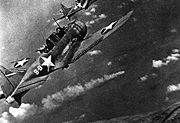 (Image:
American aircraft attacking a Japanese cruiser at the Battle of Midway.)
(Image:
American aircraft attacking a Japanese cruiser at the Battle of Midway.)
In early May, Japan initiated operations to capture Port Moresby via amphibious assault and thus sever the line of communications between the United States and Australia. The Allies, however, intercepted and turned back Japanese naval forces, preventing the invasion. Japan's next plan, motivated by the earlier bombing on Tokyo, was to seize Midway Atoll and lure American carriers into battle to be eliminated; as a diversion, Japan would also send forces to occupy the Aleutian Islands. In early June, Japan put their operations into action but the Americans, having broken Japanese naval codes in late May, were fully aware of the plans and force dispositions and used this knowledge to achieve a decisive victory over the Imperial Japanese Navy. With their capacity for aggressive action greatly diminished as a result of the Midway battle, Japan chose to focus on a belated attempt to capture Port Moresby by an overland campaign in the Territory of Papua. The Americans planned a counterattack against Japanese positions in the southern Solomon Islands, primarily Guadalcanal, as a first step towards capturing Rabaul, the main Japanese base in Southeast Asia. Both plans started in July, but by mid-September, the battle for Guadalcanal took priority for the Japanese, and troops in New Guinea were ordered to withdraw from the Port Moresby area to the northern part of the island. Guadalcanal soon became a focal point for both sides with heavy commitments of troops and ships in a battle of attrition. By the start of 1943, the Japanese were defeated on the island and withdrew their troops.
In Burma, Commonwealth forces mounted two operations. The first, an offensive into the Arakan region in late 1942 went disastrously, forcing a retreat back to India by May 1943. The second was the insertion of irregular forces behind Japanese front-lines in February which, by the end of April, had achieved dubious results.
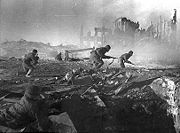 (Image:
Soviet soldiers in the Battle of Stalingrad.)
(Image:
Soviet soldiers in the Battle of Stalingrad.)
On Germany's eastern front, the Axis defeated Soviet offensives in the Kerch Peninsula and at Kharkov and then launched their main summer offensive against southern Russia in June, 1942, to seize the oil fields of the Caucasus. The Soviets decided to make their stand at Stalingrad which was in the path of the advancing German armies and by mid-November the Germans had nearly taken Stalingrad in bitter street fighting when the Soviets began their second winter counter-offensive, starting with an encirclement of German forces at Stalingrad and an assault on the Rzhev salient near Moscow, though the latter failed disastrously. By early February, the German Army had taken tremendous losses; their troops at Stalingrad had been forced to surrender and the front-line had been pushed back beyond its position prior to their summer offensive. In mid-February, after the Soviet push had tapered off, the Germans launched another attack on Kharkov, creating a salient in their front-line around the Russian city of Kursk.
In the west, concerns the Japanese might utilize bases in Vichy-held Madagascar caused the British to invade the island in early May, 1942. This success was off set soon after by an Axis offensive in Libya which pushed the Allies back into Egypt until Axis forces were stopped at El Alamein. On the Continent, raids of Allied commandos on strategic targets, culminating in the disastrous Dieppe Raid, demonstrated the Western allies' inability to launch an invasion of continental Europe without much better preparation, equipment, and operational security. In August, the Allies succeeded in repelling a second attack against El Alamein and, at a high cost, managed to get desperately needed supplies to the besieged Malta. A few months later the Allies commenced an attack of their own in Egypt, dislodging the Axis forces and beginning a drive west across Libya. This was followed up shortly after by an Anglo-American invasion of French North Africa, which resulted in the region joining the Allies. Hitler responded to the defection by ordering the occupation of Vichy France, though the Vichy Admiralty managed to scuttle their fleet to prevent its capture by German forces. The now pincered Axis forces in Africa withdrew into Tunisia, which was conquered by the Allies by May 1943.
Allies gain momentum
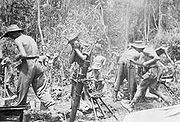 (Image:
British troops firing a mortar during the Battle of Imphal.)
(Image:
British troops firing a mortar during the Battle of Imphal.)
In mainland Asia, the Japanese launched two major offensives. The first, started in March, 1944, was against British positions in Assam, India and soon led to Japanese forces besieging Commonwealth positions at Imphal and Kohima; by May however, other Japanese forces were being besieged in Myitkyina by Chinese forces which had invaded Northern Burma in late 1943. The second was in China, with the goal of destroying China's main fighting forces, securing railways between Japanese-held territory, and capturing Allied airfields. By June the Japanese had conquered the province of Henan and begun a renewed attack against Changsha in the Hunan province.
Following the Guadalcanal Campaign, the Allies initiated several operations against Japan in the Pacific. In May, 1943, American forces were sent to eliminate Japanese forces from the Aleutians, and soon after began major operations to isolate Rabaul by capturing surrounding islands, and to breach the Japanese Central Pacific perimeter at the Gilbert and Marshall Islands. By the end of March, 1944, the Allies had completed both of these objectives, and additionally neutralized another major Japanese base in the Caroline Islands. In April, the Allies then launched an operation to retake Western New Guinea.
In the Mediterranean, Allied forces launched an invasion of Sicily in early July, 1943. The attack on Italian soil, compounded with previous failures, resulted in the ousting and arrest of Mussolini later that month. The Allies soon followed up with an invasion of the Italian mainland in early September, following an Italian armistice with the Allies. When this armistice was made public on September 8, Germany responded by disarming Italian forces, seizing military control of Italian areas, and setting up a series of defensive lines. On September 12, German special forces further rescued Mussolini who then soon established a new client state in German occupied Italy. The Allies fought through several lines until reaching the main German defensive line in mid-November. In January 1944, the Allies launched a series of attacks against the line at Monte Cassino and attempted to outflank it with landings at Anzio. By late May both of these offensives had succeeded and, at the expense of allowing several German divisions to retreat, on June 4 Rome was captured.
German operations in the Atlantic also suffered. By May 1943, German submarine losses were so high that the naval campaign was temporarily called to a halt as Allied counter-measures became increasingly effective.
In the Soviet Union, the Germans spent the spring and early summer of 1943 making preparations for a large offensive in the region of Kursk; the Soviets anticipated such an action though and spent their time fortifying the area. On July 4, the Germans launched their attack, though only about a week later Hitler cancelled the operation. The Soviets were then able to mount a massive counter-offensive and, by June 1944, had largely expelled Axis forces from the Soviet Union and made incursions into Romania.
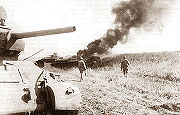 (Image:
A Soviet tank during the Battle of Kursk.)
(Image:
A Soviet tank during the Battle of Kursk.)
In November 1943, Franklin Roosevelt and Winston Churchill met with Chiang Kai-shek in Cairo and then with Joseph Stalin in Tehran. At the former conference, the post-war return of Japanese territory was determined and in the latter, it was agreed that the Western Allies would invade Europe in 1944 and that the Soviet Union would declare war on Japan within three months of Germany's defeat.
In January 1944, the Soviets expelled the German forces from the Leningrad region, ending the longest and the most lethal siege in history. The following Soviet offensive was halted on the pre-war Estonian border by the German Army Group North aided by Estonians hoping to re-establish national independence. This delay retarded subsequent Soviet operations in the Baltic Sea region.
Allies close in
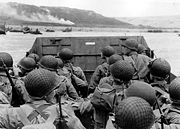 (Image: Allied
Invasion of Normandy.)
(Image: Allied
Invasion of Normandy.)
On June 6, 1944 (known as D-Day), the Western Allies invaded northern France and, after reassigning several Allied divisions from Italy, southern France. These landings were successful, and led to the defeat of the German Army units in France. Paris was liberated on 25 August and the Western Allies continued to push back German forces in western Europe during the latter part of the year. An attempt to advance into northern Germany spear-headed by a major airborne operation in Holland was not successful, however. The Allies also continued their advance in Italy until they ran into the last major German defensive line there.
On June 22, the Soviets launched a strategic offensive in Belarus (known as "Operation Bagration") that resulted in the almost complete destruction of the German Army Group Centre. Soon after that, another Soviet strategic offensive forced the German troops from Western Ukraine and Eastern Poland. Successful advance of Soviet troops prompted resistance forces in Poland to initiate several uprisings, though the largest of these, in Warsaw, as well as a Slovak Uprising in the south, were put down by German forces. The Red Army's strategic offensive in eastern Romania cut off and destroyed the considerable German troops there and triggered successful coup d'état in Romania and Bulgaria, followed by the countries' shift to the Allies side. In September 1944, Soviet Red Army advanced into Yugoslavia and forced the rapid withdrawal of the German Army Groups E and F in Greece, Albania and Yugoslavia to rescue them from being cut off. By this point, the Yugoslav Partisans under Marshal Josip Broz Tito controlled much of the Yugoslav territory and were engaged in delaying efforts against the German forces further south. In northern Serbia, the Red Army, with limited support from Bulgarian forces, assisted the Partisans in a joint liberation of the capital city of Belgrade on October 20. Few days later, the Soviets launched a massive assault against German occupied Hungary that lasted until the fall of Budapest in February 1945.
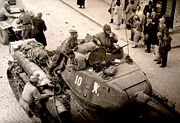 (Image:
A Soviet T-34 tank on the street of Belgrade)
(Image:
A Soviet T-34 tank on the street of Belgrade)
In contrast with impressive victories in Balkans, the bitter Finnish resistance to the Soviet offensive in the Karelian Isthmus denied the Soviet occupation of Finland and led to signing the armistice on relatively mild conditions and Finland's shift to the Allies side.
By the start of July, Commonwealth forces in Southeast Asia had repelled the Japanese sieges in Assam, pushing the Japanese back to the Chindwin River while the Chinese captured Myitkyina. In China, the Japanese were having greater successes, having finally captured Changsha in mid-June and the city of Hengyang by early August. Soon after, they further invaded the province of Guangxi, winning major engagements against Chinese forces at Guilin and Liuzhou by the end of November and successfully linking up their forces in China and Indochina by the middle of December.
In the Pacific, American forces continued to press back the Japanese perimeter. In mid-June 1944 they began their offensive against the Mariana and Palau islands, scoring a decisive victory against Japanese forces in the Philippine Sea within a few days. These defeats led to the resignation of Japanese Prime Minister T?j? and provided the United States with air bases which allowed the intensification of heavy bomber attacks on the Japanese home islands. In late October, American forces invaded the Filipino island of Leyte; soon after, Allied naval forces scored another large victory during the Battle of Leyte Gulf, which was the largest naval battle in history.
Axis collapse, Allied victory
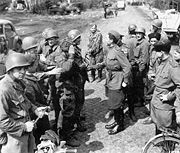 (Image:
American and Soviet troops meet east of the Elbe River.)
(Image:
American and Soviet troops meet east of the Elbe River.)
On December 16, 1944 German forces counter-attacked in the Ardennes against the Western Allies. It took six weeks for the Allies to repulse the attack. The Soviets attacked through Hungary, while the Germans abandoned Greece and Albania and were driven out of southern Yugoslavia by partisans. In Italy, the Western Allies remained stalemated at the German defensive line. In mid-January 1945, the Soviets attacked in Poland, pushing from the Vistula to the Oder river in Germany, and overran East Prussia.
On February 4, U.S., British, and Soviet leaders met in Yalta. They agreed on the occupation of post-war Germany, and when the Soviet Union would join the war against Japan.
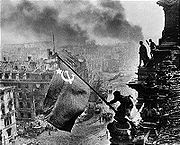 (Image:
Soviet soldiers raising the Soviet flag over the Reichstag after its capture)
(Image:
Soviet soldiers raising the Soviet flag over the Reichstag after its capture)
In February, Western Allied forces entered Germany and closed to the Rhine river, while the Soviets invaded Pomerania and Silesia. In March, the Western Allies crossed the Rhine north and south of the Ruhr, encircling a large number of German troops, while the Soviets advanced to Vienna. In early April the Western Allies finally pushed forward in Italy and swept across western Germany, while in late April Soviet forces stormed Berlin; the two forces linked up on Elbe river on April 25.
Several changes in leadership occurred during this period. On April 12, U.S. President Roosevelt died; he was succeeded by Harry Truman. Mussolini was killed by Italian partisans on April 28 and two days later Hitler committed suicide, succeeded by Grand Admiral Karl Dönitz.
German forces surrendered in Italy on April 29 and in Western Europe on May 7. However, fighting continued on the Eastern Front until the Germans surrendered specifically to the Soviets on May 8. In Prague, resistance of remnants of German Army continued until May 11.
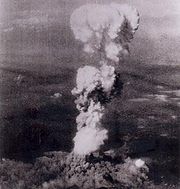 (Image: Nuclear
explosion at Hiroshima.)
(Image: Nuclear
explosion at Hiroshima.)
In the Pacific theater, American forces advanced in the Philippines, clearing Leyte by the end of 1944. They landed on Luzon in January 1945 and Mindanao in March. British and Chinese forces defeated the Japanese in northern Burma from October to March, then the British pushed on to Rangoon by May 3. American forces also moved toward Japan, taking Iwo Jima by March, and Okinawa by June. American bombers destroyed Japanese cities, and American submarines cut off Japanese imports.
On July 11, the Allied leaders met in Potsdam, Germany. They confirmed earlier agreements about Germany, and reiterated the demand for unconditional surrender by Japan, specifically stating that "the alternative for Japan is prompt and utter destruction". During this conference the United Kingdom held its general election and Clement Attlee replaced Churchill as Prime Minister.
When Japan continued to reject the Potsdam terms, the United States then dropped atomic bombs on the Japanese cities of Hiroshima and Nagasaki in early August. Between the two bombs, the Soviets invaded Japanese-held Manchuria, as agreed at Yalta. On August 15, 1945 Japan surrendered, ending the war.
Aftermath
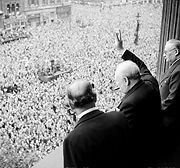 (Image:
Prime Minister Winston Churchill waves to crowds in London on Victory in Europe Day.)
(Image:
Prime Minister Winston Churchill waves to crowds in London on Victory in Europe Day.)
In an effort to maintain international peace, the Allies formed the United Nations, which officially came into existence on October 24, 1945.
Regardless of this though, the alliance between the Western Allies and the Soviet Union had begun to deteriorate even before the war was over, and the two powers each quickly established their own spheres of influence. In Europe, the continent was essentially divided between Western and Soviet spheres by the so-called Iron Curtain which ran through and partitioned Allied occupied Germany and occupied Austria. In Asia, the United States occupied Japan and administrated Japan's former islands in the Western Pacific while the Soviets annexed Sakhalin and the Kuril Islands; the former Japanese governed Korea was divided and occupied between the two powers. Mounting tensions between the United States and the Soviet Union soon evolved into the formation of the American-led NATO and the Soviet-led Warsaw Pact military alliances and the start of the Cold War between them.
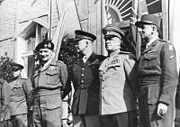 (Image:
The Supreme Commanders on June 5, 1945 in Berlin: Bernard Montgomery, Dwight D. Eisenhower, Georgy Zhukov and Jean de Lattre de Tassigny.)
(Image:
The Supreme Commanders on June 5, 1945 in Berlin: Bernard Montgomery, Dwight D. Eisenhower, Georgy Zhukov and Jean de Lattre de Tassigny.)
In many parts of the world, conflict picked up again within a short time of World War II ending. In China, nationalist and communist forces quickly resumed their civil war. Communist forces were eventually victorious and established the People's Republic of China on the mainland while nationalist forces ended up retreating to the reclaimed island of Taiwan. In Greece, civil war broke out between Anglo-American supported royalist forces and communist forces, with the royalist forces victorious. Soon after these conflicts ended, war broke out in Korea between South Korea, which was backed by the western powers, and North Korea, which was backed by the Soviet Union and China; the war resulted in essentially a stalemate and ceasefire.
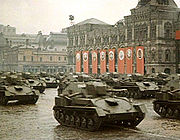 (Image:
Soviet tanks on parade in Moscow after the defeat of Germany.)
(Image:
Soviet tanks on parade in Moscow after the defeat of Germany.)
Following the end of the war, a rapid period of decolonization also took place within the holdings of the various European colonial powers. These primarily occurred due to shifts in ideology, the economic exhaustion from the war and increased demand by indigenous people for self-determination. For the most part, these transitions happened relatively peacefully, though notable exceptions occurred in countries such as Indochina, Madagascar, Indonesia and Algeria. In many regions, divisions, usually for ethnic or religious reasons, occurred following European withdrawal; this was seen prominently in the Mandate of Palestine, leading to the creation of Israel and Palestine, and in India, resulting in the creation of the Dominion of India and the Dominion of Pakistan.
Economic recovery following the war was varied in differing parts of the world, though in general it was quite positive. In Europe, West Germany recovered quickly and doubled production from its pre-war levels by the 1950s. Italy came out of the war in poor economic condition, but by 1950s, the Italian economy was marked by stability and high growth. The United Kingdom was in a state of economic ruin after the war, and continued to experience relative economic decline for decades to follow. France rebounded quite quickly, and enjoyed rapid economic growth and modernization. The Soviet Union also experienced a rapid increase in production in the immediate post-war era. In Asia, Japan experienced incredibly rapid economic growth, and led to Japan becoming one of the most powerful economies in the world by the 1980s. China, following the conclusion of its civil war, was essentially a bankrupt nation. By 1953 economic restoration seemed fairly successful as production had resumed pre-war levels. This growth rate mostly persisted, though it was briefly interrupted by the disastrous Great Leap Forward economic experiment. At the end of the war, the United States produced roughly half of the world's industrial output; by the 1970s though, this dominance had lessened significantly.
Impact of the war
Casualties and war crimes
World War II deaths
Estimates for the total casualties of the war vary, but most suggest that some 60 million people died in the war, including about 20 million soldiers and 40 million civilians. Many civilians died because of disease, starvation, massacres, bombing and deliberate genocide. The Soviet Union lost around 27 million people during the war, about half of all World War II casualties. Of the total deaths in World War II, approximately 85 percent were on the Allied side (mostly Soviet and Chinese) and 15 percent on the Axis side. One estimate is that 12 million civilians died in Nazi concentration camps, 1.5 million by bombs, 7 million in Europe from other causes, and 7.5 million in China from other causes. Figures on the amount of total casualties vary to a wide extent because the majority of deaths were not documented.
Many of these deaths were a result of genocidal actions committed in Axis-occupied territories and other war crimes committed by German as well as Japanese forces. The most notorious of German atrocities was The Holocaust, the systematic genocide of Jews in territories controlled by Germany and its allies. The Nazis also targeted other groups, including the Roma (targeted in the Porajmos), Slavs, and gay men, exterminating an estimated five million additional people. The targets of Ustase regime were mostly Serbs. For Japan, the most well-known atrocity is the Nanking Massacre, in which several hundred thousand Chinese civilians were raped and murdered. The Japanese military murdered from nearly 3 million to over 10 million civilians, mostly Chinese. According to Mitsuyoshi Himeta, at least 2.7 million died during the Sanko Sakusen implemented in Heipei and Shantung by General Yasuji Okamura.
Limited Axis usage of biological and chemical weapons is also known. The Italians used mustard gas during their conquest of Abyssinia, while the Japanese Imperial Army used a variety of such weapons during their invasion and occupation of China and in early conflicts against the Soviets. Both the Germans and Japanese tested such weapons against civilians and, in some cases, on prisoners of war.
While many of the Axis's acts were brought to trial in the world's first international tribunals, incidents caused by the Allies were not. Examples of such actions include population transfer in the Soviet Union, the Soviet forced labour camps (Gulag), Japanese American internment in the United States, the Operation Keelhaul, expulsion of Germans after World War II, the Soviet massacre of Polish citizens and the controversial mass-bombing of civilian areas in enemy territory, including Tokyo and most notably at Dresden.
Large numbers of deaths can also be attributed, if even partially, indirectly to the war, such as the Bengal famine of 1943.
Concentration camps and slave work
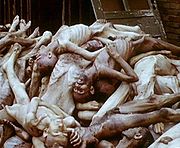 (Image: Victims of
the Holocaust.)
(Image: Victims of
the Holocaust.)
The Nazis were responsible for the killing of approximately six million Jews (overwhelmingly Ashkenazi) as well as two million ethnic Poles and four million others who were deemed "unworthy of life" (including the disabled and mentally ill, Soviet POWs, homosexuals, Freemasons, Jehovah's Witnesses, and the Roma) as part of a program of deliberate extermination planned and executed by the Nazi Germany. About 12 million, most of whom were Eastern Europeans, were employed in the German war economy as forced labor in Germany during World War II.
In addition to the Nazi concentration camps, the Soviet Gulag, or labor camps, led to the death of citizens of occupied countries such as Poland, Lithuania, Latvia, and Estonia, as well as German prisoners of war (POW) and even Soviet citizens themselves who had been or were thought to be supporters of the Nazis. Sixty percent of Soviet POWs died during the war. Richard Overy gives the number of 5.7 million Soviet POWs. Of those, 57% died or were killed, a total of 3.6 million. Some of the survivors on their return to the USSR were treated as traitors (see Order No. 270).
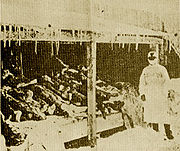 (Image:
Body disposal at Unit 731, the Japanese biological warfare research unit.)
(Image:
Body disposal at Unit 731, the Japanese biological warfare research unit.)
Japanese prisoner-of-war camps, many of which were used as labour camps, also had high death rates. The International Military Tribunal for the Far East found the death rate of Western prisoners was 27.1 percent (for American POWs, 37 percent), seven times that of POW's under the Germans and Italians The death rate among Chinese POWs was much larger; a directive ratified on August 5, 1937 by Hirohito declared that the Chinese were no longer protected under international law. While 37,583 prisoners from the UK, 28,500 from the, Netherlands and 14,473 from United States were released after the surrender of Japan, the number for the Chinese was only 56.
According to a joint study of historians featuring Zhifen Ju, Mark Peattie, Toru Kubo, and Mitsuyoshi Himeta, more than 10 million Chinese were mobilized by the Japanese army and enslaved by the Koa-in for slave labor in Manchukuo and north China. The U.S. Library of Congress estimates that in Java, between 4 and 10 million romusha (Japanese: "manual laborer"), were forced to work by the Japanese military. About 270,000 of these Javanese laborers were sent to other Japanese-held areas in South East Asia. Only 52,000 were repatriated to Java, meaning that there was a death rate of 80%.
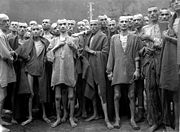 (Image:
Mistreated and starved prisoners in the Mauthausen camp, Austria, 1945.)
(Image:
Mistreated and starved prisoners in the Mauthausen camp, Austria, 1945.)
On February 19, 1942 Roosevelt signed Executive Order 9066, interning thousands of Japanese, Italians, German Americans, and some emigrants from Hawaii who fled after the bombing of Pearl Harbor for the duration of the war. 150,000 Japanese-Americans were interned by the U.S. and Canadian governments, as well as nearly 11,000 German and Italian residents of the U.S.
Allied use of slave labor occurred mainly in the east, such as in Poland, but more than a million was also put to work in the west. For example, in the 1940's, Lac Saint-Jean, along with various other regions within Canada, such as the Saguenay, Saint Helen's Island and Hull, Quebec, had Prisoner-of-war camps. By 1942 the Lac St. Jean region had 2 camps with at least 50 POWs. These prisoners were forced into hard labour which included lumbering and assisting in the production of pulp and paper. Canada's war prisons, such as St. Helen's prison, camp forty seven (Camp 47), were numbered and remained unnamed. The POWs where classified into categories including their nationality and civilian or military status. Camp 47's POWs were mostly of Italian and German nationality. These prisoners were forced into farming and lumbering the land. By 1944 Camp 47 would be closed and shortly afterwards destroyed because of an internal report on the treatment of prisoners. By December 1945 it was estimated by French authorities that 2,000 German prisoners were being killed or maimed each month in mine-clearing accidents.
Home fronts and production
In Europe, prior to the start of the war, the Allies had significant advantages in both population and economics. In 1938, the Western Allies (United Kingdom, France, Poland and British Dominions) had a 30% larger population and a 30% higher gross domestic product than the European Axis (Germany and Italy); if colonies are included, it then gives the Allies more than a 5:1 advantage in population and nearly 2:1 advantage in GDP. In Asia at the same time, China had roughly six times the population of Japan, but only an 89% higher GDP; this is reduced to three times the population and only a 38% higher GDP if Japanese colonies are included.
Though the Allies' economic and population advantages were largely mitigated during the initial rapid blitzkrieg attacks of Germany and Japan, they became the decisive factor by 1942, after the United States and Soviet Union joined the Allies, as the war largely settled into one of attrition.
While the Allies' ability to out-produce the Axis is often attributed to the Allies having more access to natural resources, other factors, such as Germany and Japan's reluctance to utilize women in the labour force, Allied strategic bombing, and Germany's late shift to a war economy contributed significantly. Additionally, neither Germany nor Japan planned on fighting a protracted war, and were not equipped to do so. To improve their production, Germany and Japan used millions of slave labourers; Germany used about 12 million people, mostly from Eastern Europe, while Japan pressed more than 18 million people in Far East Asia.
War time occupation
In Europe, occupation came under two very different forms. In western, northern and central Europe (France, Norway, Denmark, the Low Countries, and the annexed portions of Czechoslovakia) Germany established economic policies through which it collected roughly 69.5 billion reichmarks by the end of the war; this figure does not include the sizable plunder of industrial products, military equipment, raw materials and other goods. Thus, the income from occupied nations was over 40% of the income Germany collected from taxation, a figure which increased to nearly 40% of total German income as the war went on.
In the east, the much hoped for bounties of lebensraum were never attained as fluctuating front-lines and Soviet scorched earth policies denied resources to the German invaders. Unlike in the west, the Nazi racial policy encouraged excessive brutality against what it considered to be the "inferior people" of Slavic descent; most German advances were thus followed by mass executions. Although resistance groups did form in most occupied territories, they did not significantly hamper German operations in either the east or the west until late 1943.
In Asia, Japan termed nations under its occupation as being part of the Greater East Asia Co-prosperity Sphere, essentially a Japanese hegemony which it claimed was for purposes of liberating colonized peoples. Although Japanese forces were originally welcomed as liberators from European domination in many territories, their excessive brutality turned local public opinions against them within weeks. During Japan's initial conquest it captured 4 million barrels of oil left behind by retreating Allied forces, and by 1943 was able to get production in the Dutch East Indies up to 50 million barrels, 76% of its 1940 output rate.
Advances in technology and warfare
During the war, aircraft continued their roles of reconnaissance, fighters, bombers and ground-support from World War I, though each area was advanced considerably. Two important additional roles for aircraft were those of the airlift, the capability to quickly move high-priority supplies, equipment and personnel, albeit in limited quantities; and of strategic bombing, the targeted use bombs against civilian areas in the hopes of hampering enemy industry and morale. Anti-aircraft weaponry also continued to advance, including key defences such as radar and greatly improved anti-aircraft artillery, such as the German 88 mm gun. Jet aircraft saw their first limited operational use during World War II, and though their late introduction and limited numbers meant that they had no real impact during the war itself, the few which saw active service pioneered a mass-shift to their usage following the war.
At sea, while advances were made in almost all aspects of naval warfare, the two primary areas of development were focused around aircraft carriers and submarines. Although at the start of the war aeronautical warfare had relatively little success, actions at Taranto, Pearl Harbor, the South China Sea and the Coral Sea soon established the carrier as the dominant capital ship in place of the battleship. In the Atlantic, escort carriers proved to be a vital part of Allied convoys, increasing the effective protection radius dramatically and helping to seal the Mid-Atlantic gap. Beyond their increased effectiveness, carriers were also more economical than battleships due to the relatively low cost of aircraft and their not requiring to be as heavily armoured. Submarines, which had proved to be an effective weapon during the first World War were anticipated by all sides to be important in the second. The British focused development on anti-submarine weaponry and tactics, such as sonar and convoys, while Germany focused on improving its offensive capability, with designs such as the Type VII submarine and Wolf pack tactics. Gradually, continually improving Allied technologies such as the Leigh light, hedgehog, squid, and homing torpedoes proved victorious.
Land warfare changed drastically from the static front lines predominating in World War I to become much more fluid and mobile. An important change was the concept of combined arms warfare, wherein tight coordination was sought between the various elements of military forces; the tank, which had been used predominantly for infantry support in the First World War, had evolved into the primary weapon of these forces during the second. In the late 1930s, tank design was considerably more advanced in all areas then it had been during World War I, and advances continued throughout the war in increasing speed, armour and firepower. At the start of the war, most armies considered the tank to be the best weapon against itself, and developed special-purpose tanks to that effect. This line of thinking was all but negated by the poor performance of the relatively light early tank armaments against armour, and German doctrine of avoiding tank-versus-tank combat; the latter factor, along with Germany's use of combined arms, were among the key elements of their highly successful blitzkrieg tactics across Poland and France. Many means of destroying tanks, including indirect artillery, anti-tank guns (both towed and self-propelled), mines, short-ranged infantry antitank weapons, and other tanks were utilized. Even with large-scale mechanization of the various armies, the infantry remained the backbone of all forces, and throughout the war, most infantry equipment was similar to that utilized in World War I. However the United States became the first country to arm its soldiers with a semi-automatic rifle, in this case the M-1 Garand. Some of the primary advances though, were the widespread incorporation of portable machine guns, a notable example being the German MG42, and various submachine guns which were well suited to close-quarters combat in urban and jungle settings. The assault rifle, a late war development which incorporated many of the best features of the rifle and submachine gun, became the standard postwar infantry weapon for nearly all armed forces.
In terms of communications, most of the major belligerents attempted to solve the problems of complexity and security presented by utilizing large codebooks for cryptography with the creation of various ciphering machines, the most well known being the German Enigma machine. SIGINT (signals intelligence) was the countering process of decryption, with the notable examples being the British ULTRA and the Allied breaking of Japanese naval codes. Another important aspect of military intelligence was the use of deception operations, which the Allies successfully used on several occasions to great effect, such as operations Mincemeat and Bodyguard, which diverted German attention and forces away from the Allied invasions of Sicily and Normandy respectively.
Other important technological and engineering feats achieved during, or as a result of, the war include the worlds first programmable computers (Z3, Colossus, and ENIAC), guided missiles and modern rockets, the Manhattan Project's development of nuclear weapons, the development of artificial harbours and oil pipelines under the English Channel.
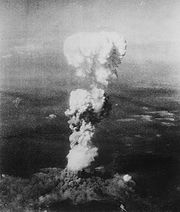
Source: WikiPedia